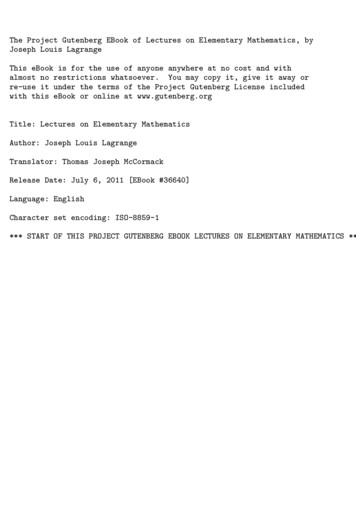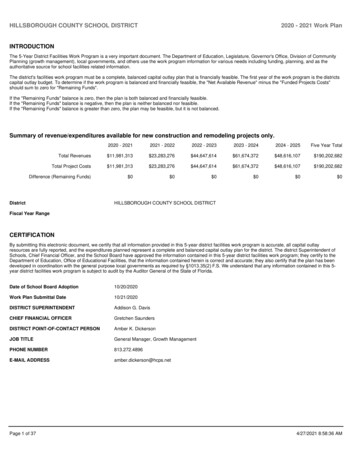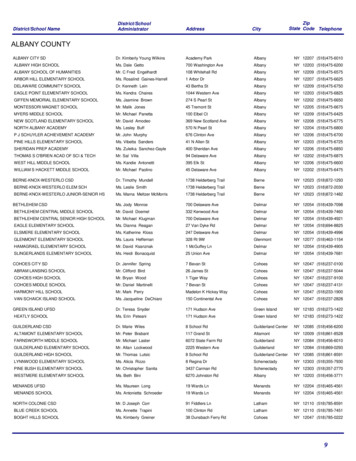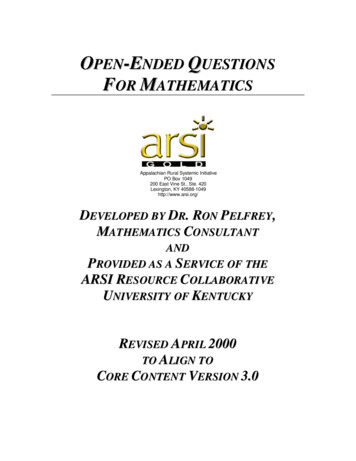
Transcription
The Project Gutenberg EBook of Lectures on Elementary Mathematics, byJoseph Louis LagrangeThis eBook is for the use of anyone anywhere at no cost and withalmost no restrictions whatsoever. You may copy it, give it away orre-use it under the terms of the Project Gutenberg License includedwith this eBook or online at www.gutenberg.orgTitle: Lectures on Elementary MathematicsAuthor: Joseph Louis LagrangeTranslator: Thomas Joseph McCormackRelease Date: July 6, 2011 [EBook #36640]Language: EnglishCharacter set encoding: ISO-8859-1*** START OF THIS PROJECT GUTENBERG EBOOK LECTURES ON ELEMENTARY MATHEMATICS **
Produced by Andrew D. Hwang.transcriber’s noteThe camera-quality files for this public-domain ebookmay be downloaded gratis atwww.gutenberg.org/ebooks/36640.This ebook was produced using OCR text provided bythe University of Toronto Gerstein Library through theInternet Archive.Minor typographical corrections and presentationalchanges have been made without comment.This PDF file is optimized for screen viewing, but mayeasily be recompiled for printing. Please consult thepreamble of the LATEX source file for instructions andother particulars.
ON ELEMENTARY MATHEMATICS
IN THE SAME SERIES.ON CONTINUITY AND IRRATIONAL NUMBERS, and ON THE NATURE ANDMEANING OF NUMBERS. By R. Dedekind. From the German by W. W.Beman. Pages, 115. Cloth, 75 cents net (3s. 6d. net).GEOMETRIC EXERCISES IN PAPER-FOLDING. By T. Sundara Row. Editedand revised by W. W. Beman and D. E. Smith. With many half-tone engravingsfrom photographs of actual exercises, and a package of papers for folding. Pages,circa 200. Cloth, 1.00 net (4s. 6d. net). (In Preparation.)ON THE STUDY AND DIFFICULTIES OF MATHEMATICS. By AugustusDe Morgan. Reprint edition with portrait and bibliographies. Pp., 288. Cloth, 1.25 net (4s. 6d. net).LECTURES ON ELEMENTARY MATHEMATICS. By Joseph Louis Lagrange.From the French by Thomas J. McCormack, With portrait and biography.Pages, 172. Cloth, 1.00 net (4s. 6d. net).ELEMENTARY ILLUSTRATIONS OF THE DIFFERENTIAL AND INTEGRALCALCULUS. By Augustus De Morgan. Reprint edition. With a bibliographyof text-books of the Calculus. Pp., 144. Price, 1.00 net (4s. 6d. net).MATHEMATICAL ESSAYS AND RECREATIONS. By Prof. Hermann Schubert,of Hamburg, Germany. From the German by T. J. McCormack. Essays onNumber, The Magic Square, The Fourth Dimension, The Squaring of the Circle.Pages, 149. Price, Cloth, 75c. net (3s. net).A BRIEF HISTORY OF ELEMENTARY MATHEMATICS. By Dr. Karl Fink, ofTübingen. From the German by W. W. Beman and D. E. Smith. Pp. 333.Cloth, 1.50 net (5s. 6d. net).THE OPEN COURT PUBLISHING COMPANY324 DEARBORN ST., CHICAGO.LONDON: Kegan Paul, Trench, Trübner & Co.
LECTURESONELEMENTARY MATHEMATICSBYJOSEPH LOUIS LAGRANGEFROM THE FRENCH BYTHOMAS J. McCORMACKSECOND EDITIONCHICAGOTHE OPEN COURT PUBLISHING COMPANYLONDON AGENTSKegan Paul, Trench, Trübner & Co., Ltd.1901
TRANSLATION COPYRIGHTEDBYThe Open Court Publishing Co.1898.
PREFACE.The present work, which is a translation of the Leçonsélémentaires sur les mathématiques of Joseph Louis Lagrange,the greatest of modern analysts, and which is to be found inVolume VII. of the new edition of his collected works, consistsof a series of lectures delivered in the year 1795 at the ÉcoleNormale,—an institution which was the direct outcome of theFrench Revolution and which gave the first impulse to modernpractical ideals of education. With Lagrange, at this institution, were associated, as professors of mathematics. Monge andLaplace, and we owe to the same historical event the final formof the famous Géométrie descriptive, as well as a second courseof lectures on arithmetic and algebra, introductory to these ofLagrange, by Laplace.With the exception of a German translation by Niedermüller(Leipsic, 1880), the lectures of Lagrange have never been published in separate form; originally they appeared in a fragmentary shape in the Séances des Écoles Normales, as they had beenreported by the stenographers, and were subsequently reprintedin the journal of the Polytechnic School. From references inthem to subjects afterwards to be treated it is to be inferredthat a fuller development of higher algebra was intended,—anintention which the brief existence of the École Normale defeated. With very few exceptions, we have left the expositionsin their historical form, having only referred in an Appendix toa point in the early history of algebra.The originality, elegance, and symmetrical character of theselectures have been pointed out by De Morgan, and notably byDühring, who places them in the front rank of elementary expo-
preface.viisitions, as an exemplar of their kind. Coming, as they do, fromone of the greatest mathematicians of modern times, and withall the excellencies which such a source implies, unique in theircharacter as a reading-book in mathematics, and interwoven withhistorical and philosophical remarks of great helpfulness, theycannot fail to have a beneficent and stimulating influence.The thanks of the translator of the present volume are dueto Professor Henry B. Fine, of Princeton, N. J., for having readthe proofs.Thomas J. McCormack.La Salle, Illinois, August 1, 1898.
JOSEPH LOUIS LAGRANGE.BIOGRAPHICAL SKETCH.A great part of the progress of formal thought, where it isnot hampered by outward causes, has been due to the invention of what we may call stenophrenic, or short-mind, symbols.These, of which all written language and scientific notations areexamples, disengage the mind from the consideration of ponderous and circuitous mechanical operations and economise itsenergies for the performance of new and unaccomplished tasksof thought. And the advancement of those sciences has beenmost notable which have made the most extensive use of theseshort-mind symbols. Here mathematics and chemistry standpre-eminent. The ancient Greeks, with all their mathematical endowment as a race, and even admitting that their powerswere more visualistic than analytic, were yet so impeded bytheir lack of short-mind symbols as to have made scarcely anyprogress whatever in analysis. Their arithmetic was a speciesof geometry. They did not possess the sign for zero, and alsodid not make use of position as an indicator of value. Evenlater, when the germs of the indeterminate analysis were disseminated in Europe by Diophantus, progress ceased here in thescience, doubtless from this very cause. The historical calculations of Archimedes, his approximation to the value of π , etc,owing to this lack of appropriate arithmetical and algebraicalsymbols, entailed enormous and incredible labors, which, if theyhad been avoided, would, with his genius, indubitably have ledto great discoveries.Subsequently, at the close of the Middle Ages, when the
biographical sketch.ixso-called Arabic figures became established throughout Europewith the symbol 0 and the principle of local value, immediateprogress was made in the art of reckoning. The problems whicharose gave rise to questions of increasing complexity and led upto the general solutions of equations of the third and fourth degree by the Italian mathematicians of the sixteenth century. Yeteven these discoveries were made in somewhat the same manner as problems in mental arithmetic are now solved in common schools; for the present signs of plus, minus, and equality,the radical and exponential signs, and especially the systematic use of letters for denoting general quantities in algebra, hadnot yet become universal. The last step was definitively due tothe French mathematician Vieta (1540–1603), and the mightyadvancement of analysis resulting therefrom can hardly be measured or imagined. The trammels were here removed from algebraic thought, and it ever afterwards pursued its way unincumbered in development as if impelled by some intrinsic andirresistible potency. Then followed the introduction of exponentsby Descartes, the representation of geometrical magnitudes byalgebraical symbols, the extension of the theory of exponentsto fractional and negative numbers by Wallis (1616–1703), andother symbolic artifices, which rendered the language of analysis as economic, unequivocal, and appropriate as the needs ofthe science appeared to demand. In the famous dispute regarding the invention of the infinitesimal calculus, while not denyingand even granting for the nonce the priority of Newton in thematter, some writers have gone so Rfar as to regard Leibnitz’sintroduction of the integral symbol as alone a sufficient substantiation of his claims to originality and independence, so faras the power of the new science was concerned.
biographical sketch.xFor the development of science all such short-mind symbolsare of paramount importance, and seem to carry within themselves the germ of a perpetual mental motion which needs nooutward power for its unfoldment. Euler’s well-known sayingthat his pencil seemed to surpass him in intelligence finds itsexplanation here, and will be understood by all who have experienced the uncanny feeling attending the rapid development ofalgebraical formulæ, where the urned thought of centuries, so tospeak, rolls from one’s finger’s ends.But it should never be forgotten that the mighty stenophrenicengine of which we here speak, like all machinery, affords usrather a mastery over nature than an insight into it; and forsome, unfortunately, the higher symbols of mathematics aremerely brambles that hide the living springs of reality. Manyof the greatest discoveries of science,—for example, those ofGalileo, Huygens, and Newton,—were made without the mechanism which afterwards becomes so indispensable for theirdevelopment and application. Galileo’s reasoning anent thesummation of the impulses imparted to a falling stone is virtualintegration; and Newton’s mechanical discoveries were made bythe man who invented, but evidently did not use to that end,the doctrine of fluxions.***We have been following here, briefly and roughly, a line ofprogressive abstraction and generalisation which even in its beginning was, psychologically speaking, at an exalted height, butin the course of centuries had been carried to points of literallyethereal refinement and altitude. In that long succession of inquirers by whom this result was effected, the process reached, we
biographical sketch.ximay say, its culmination and purest expression in Joseph LouisLagrange, born in Turin, Italy, the 30th of January, 1736, diedin Paris, April 10, 1813. Lagrange’s power over symbols has,perhaps, never been paralleled either before his day or since. Itis amusing to hear his biographers relate that in early life heevinced no aptitude for mathematics, but seemed to have beengiven over entirely to the pursuits of pure literature; for at fifteenwe find him teaching mathematics in an artillery school in Turin,and at nineteen he had made the greatest discovery in mathematical science since that of the infinitesimal calculus, namely,the creation of the algorism and method of the Calculus of Variations. “Your analytical solution of the isoperimetrical problem,”writes Euler, then the prince of European mathematicians, tohim, “leaves nothing to be desired in this department of inquiry,and I am delighted beyond measure that it has been your lotto carry to the highest pitch of perfection, a theory, which sinceits inception I have been almost the only one to cultivate.” Butthe exact nature of a “variation” even Euler did not grasp, andeven as late as 1810 in the English treatise of Woodhouse onthis subject we read regarding a certain new sign introduced,that M. Lagrange’s “power over symbols is so unbounded thatthe possession of it seems to have made him capricious.”Lagrange himself was conscious of his wonderful capacitiesin this direction. His was a time when geometry, as he himselfphrased it, had become a dead language, the abstractions ofanalysis were being pushed to their highest pitch, and he feltthat with his achievements its possibilities within certain limitswere being rapidly exhausted. The saying is attributed to himthat chairs of mathematics, so far as creation was concerned,and unless new fields were opened up, would soon be as rare at
biographical sketch.xiiuniversities as chairs of Arabic. In both research and exposition,he totally reversed the methods of his predecessors. They hadproceeded in their exposition from special cases by a speciesof induction; his eye was always directed to the highest andmost general points of view; and it was by his suppression ofdetails and neglect of minor, unimportant considerations that heswept the whole field of analysis with a generality of insight andpower never excelled, adding to his originality and profunditya conciseness, elegance, and lucidity which have made him themodel of mathematical writers.***Lagrange came of an old French family of Touraine, France,said to have been allied to that of Descartes. At the age oftwenty-six he found himself at the zenith of European fame. Buthis reputation had been purchased at a great cost. Although ofordinary height and well proportioned, he had by his ecstaticdevotion to study,—periods always accompanied by an irregular pulse and high febrile excitation,—almost ruined his health.At this age, accordingly, he was seized with a hypochondriacal affection and with bilious disorders, which accompanied himthroughout his life, and which were only allayed by his greatabstemiousness and careful regimen. He was bled twenty-ninetimes, an infliction which alone would have affected the most robust constitution. Through his great care for his health he gavemuch attention to medicine. He was, in fact, conversant withall the sciences, although knowing his forte he rarely expressedan opinion on anything unconnected with mathematics.When Euler left Berlin for St. Petersburg in 1766 he andD’Alembert induced Frederick the Great to make Lagrange pres-
biographical sketch.xiiiident of the Academy of Sciences at Berlin. Lagrange acceptedthe position and lived in Berlin twenty years, where he wrotesome of his greatest works. He was a great favorite of the Berlinpeople, and enjoyed the profoundest respect of Frederick theGreat, although the latter seems to have preferred the noisyreputation of Maupertuis, Lamettrie, and Voltaire to the unobtrusive fame and personality of the man whose achievementswere destined to shed more lasting light on his reign than thoseof any of his more strident literary predecessors: Lagrange was,as he himself said, philosophe sans crier.The climate of Prussia agreed with the mathematician. Herefused the most seductive offers of foreign courts and princes,and it was not until the death of Frederick and the intellectualreaction of the Prussian court that he returned to Paris, wherehis career broke forth in renewed splendor. He published in 1788his great Mécanique analytique, that “scientific poem” of SirWilliam Rowan Hamilton, which gave the quietus to mechanicsas then formulated, and having been made during the Revolution Professor of Mathematics at the new École Normale and theÉcole Polytechnique, he entered with Laplace and Monge uponthe activity which made these schools for generations to comeexemplars of practical scientific education, systematising by hislectures there, and putting into definitive form, the science ofmathematical analysis of which he had developed the extremestcapacities. Lagrange’s activity at Paris was interrupted onlyonce by a brief period of melancholy aversion for mathematics,a lull which he devoted to the adolescent science of chemistry andto philosophical studies; but he afterwards resumed his old lovewith increased ardor and assiduity. His significance for thoughtgenerally is far beyond what we have space to insist upon. Not
biographical sketch.xivleast of all, theology, which had invariably mingled itself withthe researches of his predecessors, was with him forever divorcedfrom a legitimate influence of science.The honors of the world sat ill upon Lagrange: la magnificence le gênait, he said; but he lived at a time when profferedthings were usually accepted, not refused. He was loaded withpersonal favors and official distinctions by Napoleon who calledhim la haute pyramide des sciences mathématiques, was madea Senator, a Count of the Empire, a Grand Officer of the Legion of Honor, and, just before his death, received the grandcross of the Order of Reunion. He never feared death, which hetermed une dernière fonction, ni pénible ni désagréable, muchless the disapproval of the great. He remained in Paris during the Revolution when savants were decidedly in disfavor, butwas suspected of aspiring to no throne but that of mathematics.When Lavoisier was executed he said: “It took them but a moment to lay low that head; yet a hundred years will not sufficeperhaps to produce its like again.”Lagrange would never allow his portrait to be painted, maintaining that a man’s works and not his personality deservedpreservation. The frontispiece to the present work is from asteel engraving based on a sketch obtained by stealth at a meeting of the Institute. His genius was excelled only by the purityand nobleness of his character, in which the world never evensought to find a blot, and by the exalted Pythagorean simplicity of his life. He was twice married, and by his wonderful careof his person lived to the advanced age of seventy-seven years,not one of which had been misspent. His life was the veriestincarnation of the scientific spirit; he lived for nothing else. Heleft his weak body, which retained its intellectual powers to the
biographical sketch.xvvery last, as an offering upon the altar of science, happily madewhen his work had been done; but to the world he bequeathedhis “ever-living” thoughts now recently resurgent in a new andmonumental edition of his works (published by Gauthier-Villars,Paris). Ma vie est là! he said, pointing to his brain the day before his death.Thomas J. McCormack.
CONTENTS.Preface . . . . . . . . . . . . . . . . . . . . . . . . . . . . . . . . . . . . . . . . . . . . . . . . viBiographical Sketch of Joseph Louis Lagrange. . . . . . viiiLecture I. On Arithmetic, and in Particular Fractions and Logarithms. . . . . . . . . . . . . . . . . . . . . . . . . . . . .1Systems of numeration. — Fractions. — Greatestcommon divisor. — Continued fractions. — Terminating continued fractions. — Converging fractions.— Convergents. — A second method of expression.— A third method of expression. — Origin of continued fractions. — Involution and evolution. —Proportions. — Arithmetical and geometrical proportions. — Progressions. — Compound interest.— Present values and annuities. — Logarithms.— Napier (1550–1617). — Origin of logarithms.— Briggs (1556–1631). Vlacq. — Computation oflogarithms. — Value of the history of science. —Musical temperament.Lecture II.On the Operations of Arithmetic. . . . . . .Arithmetic and geometry. — New method ofsubtraction. — Subtraction by complements. —20
contents.xviiAbridged multiplication. — Inverted multiplication. — Approximate multiplication. — The newmethod exemplified. — Division of decimals. —Property of the number 9. — Property of thenumber 9 generalised. — Theory of remainders. —Test of divisibility by 7. — Negative remainders.— Test of divisibility by 11. — Theory of remainders. — checks on multiplication and division.— Evolution. — Rule of three. — Applicabilityof the rule of three. — Theory and practice.— Alligation. — Mean values. — Probability oflife. — Alternate alligation. — Two ingredients.— Rule of mixtures. — Three ingredients. —General solution. — Development. — Resolutionby continued fractions.Lecture III. On Algebra, Particularly the Resolution of Equations of the Third and Fourth Degree. . . . . . . . . . . . . . . . . . . . . . . . . . . . . . . . . . . . . . . . . . . . . . .Algebra among the ancients. — Diophantus. —Equations of the second degree. — Other problemssolved by Diophantus. — Translations of Diophantus. — Algebra among the Arabs. — Algebra inEurope. — Tartaglia (1500–1559). Cardan (1501–1576). — The irreducible case. — Biquadratic equations. — Ferrari (1522-1565). Bombelli. — Theoryof equations. — Equations of the third degree. —The reduced equation. — Cardan’s rule. — Thegenerality of algebra. — The three cube roots ofa quantity. — The roots of equations of the third46
contents.xviiidegree. — A direct method of reaching the roots.— The form of the roots. — The reality of theroots. — The form of the two cubic radicals. —Condition of the reality of the roots. — Extractionof the square roots of two imaginary binomials.— Extraction of the cube roots of two imaginary binomials. — General theory of the realityof the roots. — Imaginary expressions. — Trisection of an angle. — Trigonometrical solution. —The method of indeterminates. — An independentconsideration. — New view of the reality of theroots. — Final solution on the new view. — Officeof imaginary quantities. — Biquadratic equations.— The method of Descartes. — The determinedcharacter of the roots. — A third method. — Thereduced equation. — Euler’s formulæ. — Roots ofa biquadratic equation.Lecture IV. On the Resolution of Numerical Equations. . . . . . . . . . . . . . . . . . . . . . . . . . . . . . . . . . . . . . . . . . . . . . .Limits of the algebraical resolution of equations. —Conditions of the resolution of numerical equations.— Position of the roots of numerical equations. —Position of the roots of numerical equations. —Application of geometry to algebra. — Representation of equations by curves. — Graphic resolutionof equations. — The consequences of the graphicresolution. — Intersections indicate the roots. —Case of multiple roots. — General conclusions asto the character of the roots. — Limits of the real87
contents.xixroots of equations. — Limits of the positive andnegative roots. — Superior and inferior limits ofthe positive roots. — A further method for findingthe limits. — The real problem, the finding of theroots. — Separation of the roots. — To find aquantity less than the difference between any tworoots. — The equation of differences. — Impracticability of the method. — Attempt to remedythe method. — Further improvement. — Finalresolution. — Recapitulation. — The arithmetical progression revealing the roots. — Method ofelimination. — General formulæ for elimination. —General result. — A second construction for solvingequations. — The development and solution. — Amachine for solving equations.Lecture V. On the Employment of Curves in the Solution of Problems. . . . . . . . . . . . . . . . . . . . . . . . . . . . . . . 115Geometry applied to algebra. — Method of resolution by curves. — Problem of the two lights.— Various solutions. — General solution. — Minimal values. — Preceding analysis applied to biquadratic equations. — Consideration of equationsof the fourth degree. — Advantages of the methodof curves. — The curve of errors. — Solution ofa problem by the curve of errors. — Problem ofthe circle and inscribed polygon. — Solution of asecond problem by the curve of errors. — Problemof the observer and three objects. — Employmentof the curve of errors. — Eight possible solutions
contents.xxof the preceding problem. — Reduction of the possible solutions in practice. — General conclusionon the method of curves. — Parabolic curves. —Newton’s problem. — Simplification of Newton’ssolution. — Possible uses of Newton’s problem. —Application of Newton’s problem to the precedingexamples.Appendix . . . . . . . . . . . . . . . . . . . . . . . . . . . . . . . . . . . . . . . . . . . . . . . 136Note on the Origin of Algebra.Index . . . . . . . . . . . . . . . . . . . . . . . . . . . . . . . . . . . . . . . . . . . . . . . . . . 138
LECTURE I.ON ARITHMETIC, AND IN PARTICULAR FRACTIONSAND LOGARITHMS.Arithmetic is divided into two parts. The first is based onthe decimal system of notation and on the manner of arrangingnumeral characters to express numbers. This first part comprisesthe four common operations of addition, subtraction, multiplication, and division,—operations which, as you know, would bedifferent if a different system were adopted, but, which it wouldnot be difficult to transform from one system to another, if achange of systems were desirable.The second part is independent of the system of numeration.It is based on the consideration of quantities and on the generalproperties of numbers. The theory of fractions, the theory ofpowers and of roots, the theory of arithmetical and geometricalprogressions, and, lastly, the theory of logarithms, fall under thishead. I purpose to advance, here, some remarks on the differentbranches of this part of arithmetic.It may be regarded as universal arithmetic, having an intimate affinity to algebra. For, if instead of particularising thequantities considered, if instead of assigning them numerically,we treat them in quite a general way, designating them by letters, we have algebra.You know what a fraction is. The notion of a fraction isslightly more composite than that of whole numbers. In wholenumbers we consider simply a quantity repeated. To reach thenotion of a fraction it is necessary to consider the quantity divided into a certain number of parts. Fractions represent in
on arithmetic.2general ratios, and serve to express one quantity by means of another. In general, nothing measurable can be measured exceptby fractions expressing the result of the measurement, unless themeasure be contained an exact number of times in the thing tobe measured.You also know how a fraction can be reduced to its lowestterms. When the numerator and the denominator are both divisible by the same number, their greatest common divisor canbe found by a very ingenious method which we owe to Euclid.This method is exceedingly simple and lucid, but it may berendered even more palpable to the eye by the following consideration. Suppose, for example, that you have a given length,and that you wish to measure it. The unit of measure is given,and you wish to know how many times it is contained in thelength. You first lay off your measure as many times as you canon the given length, and that gives you a certain whole numberof measures. If there is no remainder your operation is finished.But if there be a remainder, that remainder is still to be evaluated. If the measure is divided into equal parts, for example,into ten, twelve, or more equal parts, the natural procedure isto use one of these parts as a new measure and to see how manytimes it is contained in the remainder. You will then have forthe value of your remainder, a fraction of which the numerator isthe number of parts contained in the remainder and the denominator the total number of parts into which the given measureis divided.I will suppose, now, that your measure is not so divided butthat you still wish to determine the ratio of the proposed lengthto the length which you have adopted as your measure. Thefollowing is the procedure which most naturally suggests itself.
on arithmetic.3If you have a remainder, since that is less than the measure,naturally you will seek to find how many times your remainderis contained in this measure. Let us say two times, and that aremainder is still left. Lay this remainder on the preceding remainder. Since it is necessarily smaller, it will still be containeda certain number of times in the preceding remainder, say threetimes, and there will be another remainder or there will not; andso on. In these different remainders you will have what is calleda continued fraction. For example, you have found that the measure is contained three times in the proposed length. You have,to start with, the number three. Then you have found that yourfirst remainder is contained twice in your measure. You willhave the fraction one divided by two. But this last denominatoris not complete, for it was supposed there was still a remainder.That remainder will give another and similar fraction, which isto be added to the last denominator, and which by our supposition is one divided by three. And so with the rest. You willthen have the fraction13 2 1.3 .as the expression of your ratio between the proposed length andthe adopted measure.Fractions of this form are called continued fractions, and canbe reduced to ordinary fractions by the common rules. Thus,if we stop at the first fraction, i.e., if we consider only the firstremainder and neglect the second, we shall have 3 12 , which isequal to 72 . Considering only the first and the second remainders,
4on arithmetic.we stop at the second fraction, and shall have 3 2 131. Now2 13 73 . We shall have therefore 3 37 , which is equal to247 .And so on with the rest. If we arrive in the course of the operation at a remainder which is contained exactly in the precedingremainder, the operation is terminated, and we shall have in thecontinued fraction a common fraction that is the exact value ofthe length to be measured, in terms of the length which servedas our measure. If the operation is not thus terminated, it canbe continued to infinity, and we shall have only fractions whichapproach more and more nearly to the true value.If we now compare this procedure with that employed forfinding the greatest common divisor of two numbers, we shallsee that it is virtually the same thing; the difference being thatin finding the greatest common divisor we devote our attentionsolely to the different remainders, of which the last is the divisorsought, whereas by employing the successive quotients, as wehave done above, we obtain fractions which constantly approachnearer and nearer to the fraction formed by the two numbersgiven, and of which the last is that fraction itself reduced to itslowest terms.As the theory of continued fractions is little known, but is yetof great utility in the solution of important numerical questions,I
Jul 06, 2011 · LECTURES ON ELEMENTARY MATHEMATICS. By Joseph Louis Lagrange. From the French by Thomas J. McCormack, With portrait and biography. Pages, 172. Cloth, 1.00 net (4s. 6d. net). ELEMENTARY ILLUSTRATIONS OF THE DIFFERENTIAL AND INTEGRAL CALCULUS. By Augustus De Morgan. Reprint edition. Wi










